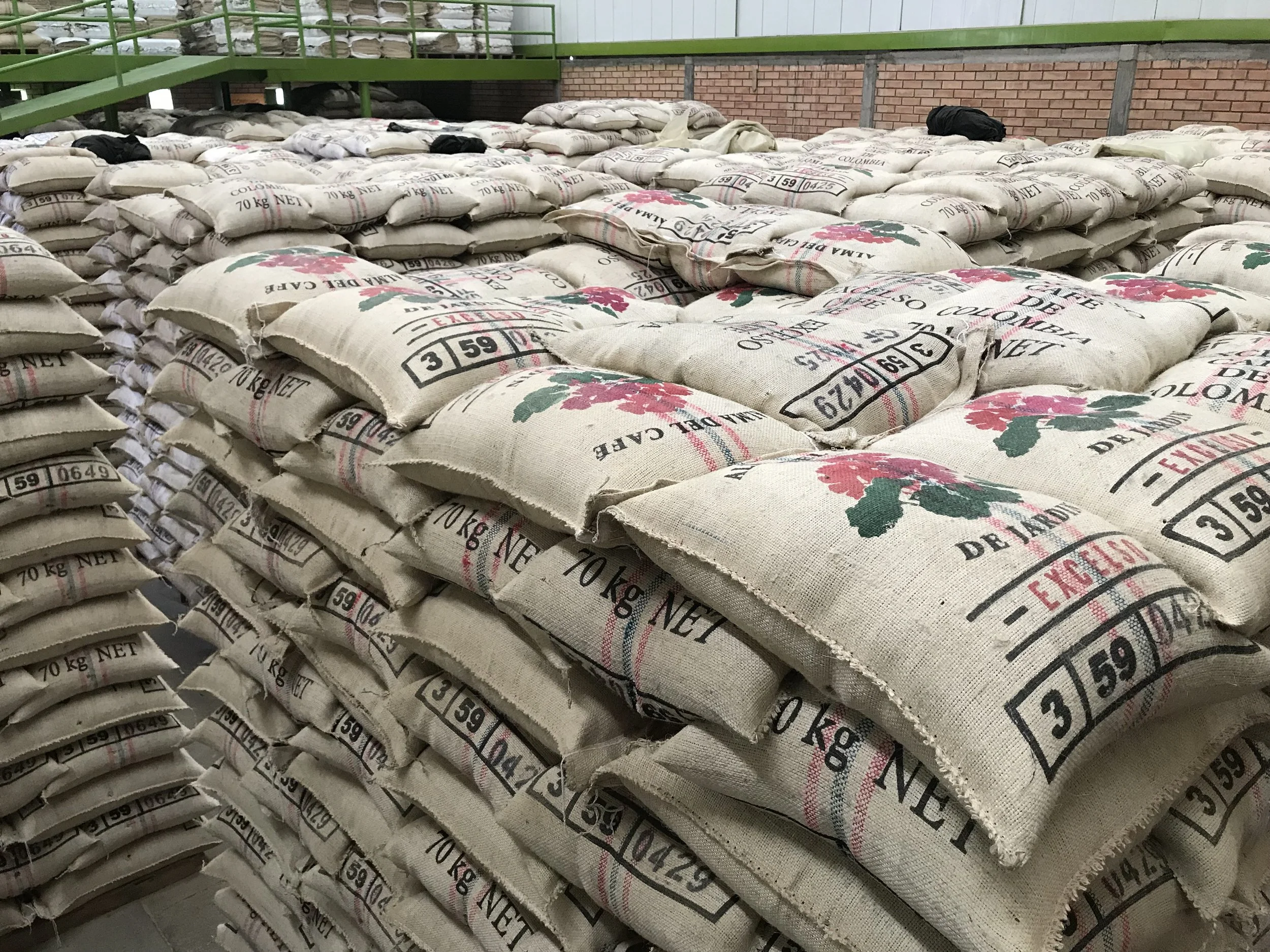Jim and I just returned from a client trip to visit our joint-venture trilladora in Jardín Colombia. We checked on crop health, production status, mill busy-ness, and general health of coffee flow in Jardin as it pertains to our operation there. We enjoy showing clients and potential customers how we conduct ourselves in the communities where we operate at origin. If you haven’t visited before, we encourage you to contact your sales rep and get in line for one of our upcoming trips!
Harvest season in Southern Antioquia is past peak and slowing down. Producers are spending more time now on processing than picking, and bringing their parchment coffee to market. Our trilladora has been quite busy purchasing coffee. We have been paying above local competition prices for some time which brings a majority of quality minded producers to us as their first option. The mill was bustling; each day of our stay saw trucks, jeeps and cars loaded with parchment lined up at the mill to sell. The warehouse was at about 80% capacity with parchment coffee in inventory waiting to be processed, with 8 full lots prepared for export waiting for trucks to arrive for shipment to port. A majority of the coffee we have on hand is from the very nearby areas of Jardín and Andes. The remaining volume comes from the other southwestern Antioqua regions of Betania, Bolivar, Salgar, and Concordia.
We visited four small farms, all with their own wet beneficios, each one of them harvesting a bit and processing coffee. We saw mostly quite healthy trees and healthy environments. There was little sign of decimating coffee leaf rust in the areas we visited. It should be noted that while many producers have added the leaf resistant variety Castillo to their farms, in most cases they’ve only used Castillo as a COLOMBIA JARDÍN TRIP RECAP DEC 3-7, 2018 Jim and I just returned from a client trip to visit our joint-venture trilladora in Jardín Colombia. We checked on crop health, production status, mill busy-ness, and general health of coffee flow in Jardin as it pertains to our operation there. We enjoy showing clients and potential customers how we conduct ourselves in the communities where we operate at origin. If you haven’t visited before, we encourage you to contact your sales rep and get in line for one of our upcoming trips. sales@laminita.com supplement to the other varieties, and still rely heavily on Caturra, with F6, Taby, and some Colombiana and Rosario thrown in for good measure. Anecdotally, there were lots of new young cherries coming in, indicating a nice mid-crop for 2019.
Drying has been increasingly difficult due to the unpredictable weather and threat of rain. Every visit we see new methods implemented to cover drying patios. Whether permanent plastic greenhouse-type covers, or the sliding rooftop system popular in Colombia, each producer has been improving their ability to deal with rain by adding some kind of covering to their patios. Most of them also have backup drying facilities of secadoras for overflow or drying during extended wet periods. One of the visits we anticipated was to see the operations of the Resguardo Indigena de Christiania group. We purchased quite a few small lots from them in 2018 that qualified for our Premium Producer program in Jardin. This program rewards producers who come to us with higher than usual quality lots that meet specific grading requirements, and then pass our cupping evaluation. If a lot qualifies, the producer is paid an additional quality premium of 15 cents per lb on top of our already area-leading high prices. The members of the RIC group were welcoming and as interested in meeting the buyers as we were in seeing them. Our local team has been regularly communicating and visiting with these suppliers, but this was our first time bringing actual end buyers to them for introductions. We were treated to a series of local dances and one raucous song, and shown their small roasting and grinding operation, where they hope to supplement their incomes by selling this coffee to tourists and locals. sales@laminita.com
Another important component to our visits is cupping. We cup many lots of coffees to show clients the range of quality possibilities in the area, along with export qualities and finished products. We tasted and evaluated coffees from a few of the neighboring regions; the standouts this time were coffees from Jardin, Salgar and Concordia. The winy and complex cup character that identifies coffee specifically from Jardin to me was obvious and intense in those samples. The Salgar and Concordia lots showed high acidity and limey citrusy notes, and were favored by many cuppers. It is always interesting to see how reactions differ between groups of cuppers and buyers, and to learn what differences each type or group prefer. As a group we cupped 14 Premium program lots that had already passed the Factor test and were just awaiting cupping evaluation by Jim. Many cuppers enjoyed these coffees and we sold a few before the day was out! It was noted that some of the samples were still a bit fresh but overall quality was quite nice with more than a few standouts.
As usual, the weeks preceding Christmas are quite festive in Antioquia and especially so in Jardin. The church and square were strung with lights and lanterns, and Christmas decorations and Nativity scenes were visible at nearly every house.
-Scott Merle, VP of Sales

